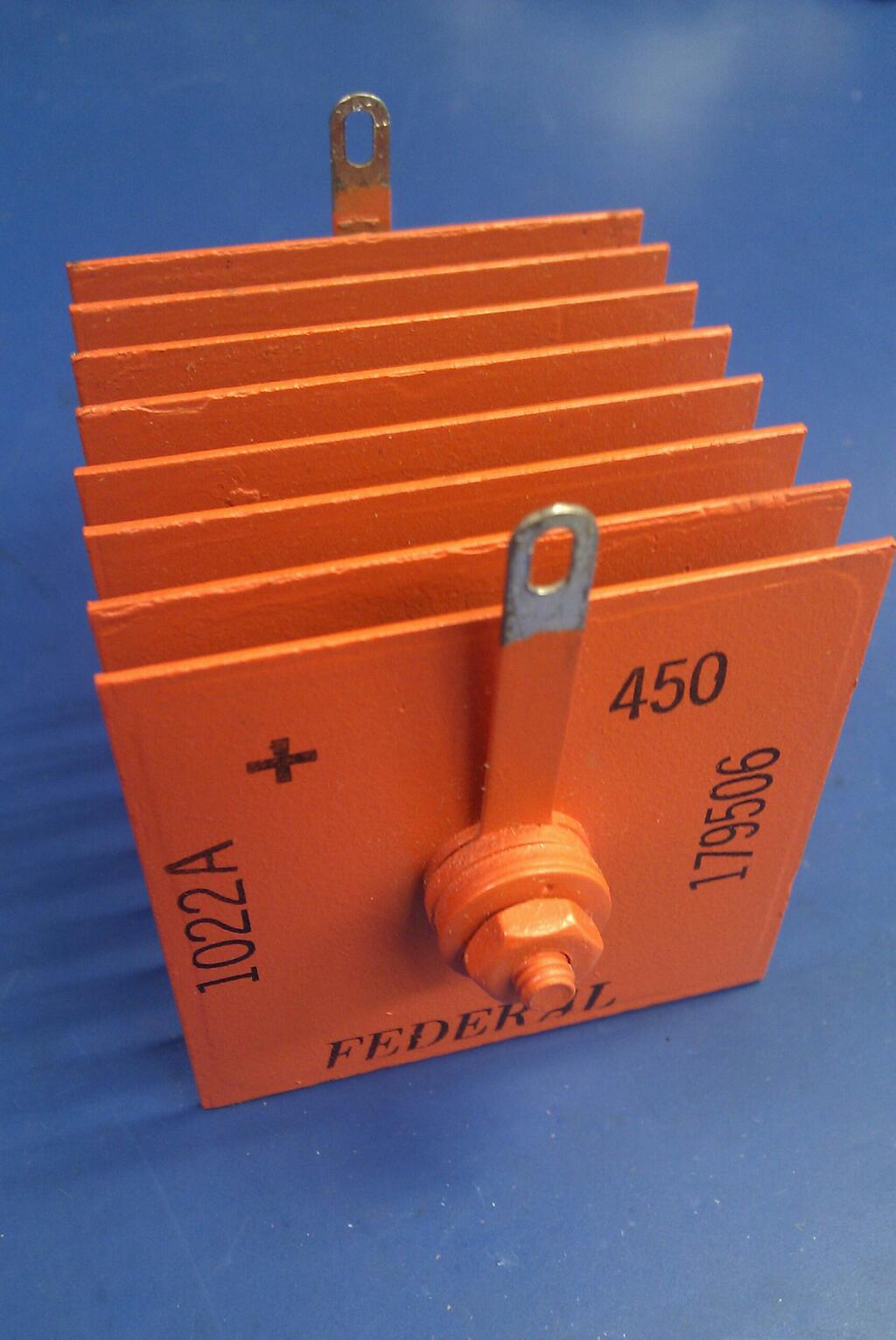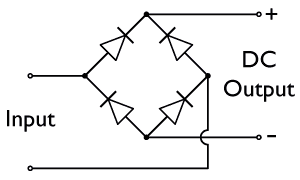|
Metal Rectifier
A metal rectifier is an early type of semiconductor rectifier in which the semiconductor is copper oxide, germanium or selenium. They were used in power applications to convert alternating current to direct current in devices such as radios and battery chargers. Westinghouse Electric was a major manufacturer of these rectifiers since the late 1920s, under the trade name Westector (now used as a trade name for an overcurrent trip device by Westinghouse Nuclear). In some countries the term "metal rectifier" is applied to all such devices; in others the term "metal rectifier" normally refers to copper-oxide types, and "selenium rectifier" to selenium-iron types. Description Metal rectifiers consist of washer-like discs of different metals, either copper (with an oxide layer to provide the rectification) or steel or aluminium, plated with selenium. The discs are often separated by spacer sleeves to provide cooling. Mode of operation The principle of operation of a metal rect ... [...More Info...] [...Related Items...] OR: [Wikipedia] [Google] [Baidu] |
Selenium Rectifier
A selenium rectifier is a type of metal rectifier, invented in 1933. They were used in power supplies for electronic equipment and in high-current battery-charger applications until they were superseded by silicon diode rectifiers in the late 1960s. The arrival of the alternator in some automobiles was the result of compact, low-cost, high-current silicon rectifiers. These units were small enough to be inside the alternator case, unlike the selenium units that preceded silicon devices. The rectifying properties of selenium, amongst other semiconductors, were observed by Braun, Schuster and Siemens between 1874 and 1883. The photoelectric and rectifying properties of selenium were also observed by Adams and Day in 1876 and C. E. Fitts around 1886, but practical rectifier devices were not manufactured routinely until the 1930s. Compared with the earlier copper-oxide rectifier, the selenium cell could withstand higher voltage, but at a lower current capacity per unit area. Construc ... [...More Info...] [...Related Items...] OR: [Wikipedia] [Google] [Baidu] |
Plating
Plating is a surface covering in which a metal is deposited on a conductive surface. Plating has been done for hundreds of years; it is also critical for modern technology. Plating is used to decorate objects, for corrosion inhibition, to improve solderability, to harden, to improve wearability, to reduce friction, to improve paint adhesion, to alter conductivity, to improve IR reflectivity, for radiation shielding, and for other purposes. Jewelry typically uses plating to give a silver or gold finish. Thin-film deposition has plated objects as small as an atom, therefore plating finds uses in nanotechnology. There are several plating methods, and many variations. In one method, a solid surface is covered with a metal sheet, and then heat and pressure are applied to fuse them (a version of this is Sheffield plate). Other plating techniques include electroplating, vapor deposition under vacuum and sputter deposition. Recently, plating often refers to using liquids. Metallizing ... [...More Info...] [...Related Items...] OR: [Wikipedia] [Google] [Baidu] |
Extra High Tension
High voltage electricity refers to electrical potential large enough to cause injury or damage. In certain industries, ''high voltage'' refers to voltage above a certain threshold. Equipment and conductors that carry high voltage warrant special safety requirements and procedures. High voltage is used in electrical power distribution, in cathode ray tubes, to generate X-rays and particle beams, to produce electrical arcs, for ignition, in photomultiplier tubes, and in high-power amplifier vacuum tubes, as well as other industrial, military and scientific applications. Definition The numerical definition of depends on context. Two factors considered in classifying a voltage as high voltage are the possibility of causing a spark in air, and the danger of electric shock by contact or proximity. The International Electrotechnical Commission and its national counterparts (IET, IEEE, VDE, etc.) define ''high voltage'' as above 1000 V for alternating current, and at l ... [...More Info...] [...Related Items...] OR: [Wikipedia] [Google] [Baidu] |
High Voltage
High voltage electricity refers to electrical potential large enough to cause injury or damage. In certain industries, ''high voltage'' refers to voltage above a certain threshold. Equipment and conductors that carry high voltage warrant special safety requirements and procedures. High voltage is used in electrical power distribution, in cathode ray tubes, to generate X-rays and particle beams, to produce electrical arcs, for ignition, in photomultiplier tubes, and in high-power amplifier vacuum tubes, as well as other industrial, military and scientific applications. Definition The numerical definition of depends on context. Two factors considered in classifying a voltage as high voltage are the possibility of causing a spark in air, and the danger of electric shock by contact or proximity. The International Electrotechnical Commission and its national counterparts (IET, IEEE, VDE, etc.) define ''high voltage'' as above 1000 V for alternating current, and at ... [...More Info...] [...Related Items...] OR: [Wikipedia] [Google] [Baidu] |
AAA Battery
The AAA battery (or triple-A battery) is a standard size of dry cell Battery (electricity), battery. One or more AAA batteries are commonly used in low-drain portable electronic devices. A zinc–carbon battery in this size is designated by International Electrotechnical Commission, IEC as R03, by ANSI C18.1 as 24, by old Japanese Industrial Standards, JIS standard as UM-4, and by other manufacturer and national standard designations that vary depending on the cell chemistry. The size was first introduced by Eveready Battery Company, The American Ever Ready Company in 1911. An AAA battery is a single cell that measures in diameter and in length, including the positive terminal button, which is a minimum . The positive terminal has a maximum diameter of ; the flat negative terminal has a minimum diameter of . Alkaline battery, Alkaline AAA batteries weigh around , while primary lithium battery, lithium AAA batteries weigh about . Rechargeable Nickel–metal hydride battery, n ... [...More Info...] [...Related Items...] OR: [Wikipedia] [Google] [Baidu] |
Diode
A diode is a two-terminal electronic component that conducts current primarily in one direction (asymmetric conductance); it has low (ideally zero) resistance in one direction, and high (ideally infinite) resistance in the other. A diode vacuum tube or thermionic diode is a vacuum tube with two electrodes, a heated cathode and a plate, in which electrons can flow in only one direction, from cathode to plate. A semiconductor diode, the most commonly used type today, is a crystalline piece of semiconductor material with a p–n junction connected to two electrical terminals. Semiconductor diodes were the first semiconductor electronic devices. The discovery of asymmetric electrical conduction across the contact between a crystalline mineral and a metal was made by German physicist Ferdinand Braun in 1874. Today, most diodes are made of silicon, but other semiconducting materials such as gallium arsenide and germanium are also used. Among many uses, diodes are found in ... [...More Info...] [...Related Items...] OR: [Wikipedia] [Google] [Baidu] |
Envelope Detector
An envelope detector (sometimes called a peak detector) is an electronic circuit that takes a (relatively) high-frequency amplitude modulated signal as input and provides an output, which is the demodulated ''envelope'' of the original signal. Circuit operation The capacitor in the circuit above stores charge on the rising edge and releases it slowly through the resistor when the input signal amplitude falls. The diode in series rectifies the incoming signal, allowing current flow only when the positive input terminal is at a higher potential than the negative input terminal. General considerations Most practical envelope detectors use either half-wave or full-wave rectification of the signal to convert the AC audio input into a pulsed DC signal. Filtering is then used to smooth the final result. This filtering is rarely perfect and some "ripple" is likely to remain on the envelope follower output, particularly for low frequency inputs such as notes from a bass instrum ... [...More Info...] [...Related Items...] OR: [Wikipedia] [Google] [Baidu] |
Bridge Rectifier
A diode bridge is a bridge rectifier circuit of four diodes that is used in the process of converting alternating current (AC) from the input terminals to direct current (DC, i.e. fixed polarity) on the output terminals. Its function is to convert the negative-going AC pulses into positive going pulses, after which a low-pass filter can be used to smooth the result into DC. When used in its most common application, for conversion of an alternating-current (AC) input into a direct-current (DC) output, it is known as a bridge rectifier. A bridge rectifier provides full-wave rectification from a two-wire AC input, resulting in lower cost and weight as compared to a rectifier with a three-wire input from a transformer with a center-tapped secondary winding. The essential feature of a diode bridge is that the polarity of the output is the same regardless of the polarity at the input. The diode bridge circuit was invented by Polish electrotechnician Karol Pollak and patented in De ... [...More Info...] [...Related Items...] OR: [Wikipedia] [Google] [Baidu] |
Cadmium Selenide
Cadmium selenide is an inorganic compound with the formula Cadmium, CdSelenide, Se. It is a black to red-black solid that is classified as a II-VI semiconductor of the n-type semiconductor, n-type. Much of the current research on this compound is focused on its nanoparticles. Structure Three crystalline forms of CdSe are known which follow the structures of: Wurtzite (crystal structure), wurtzite (hexagonal), Cubic crystal system#Zincblende structure, sphalerite (cubic) and Cubic crystal system#Rock-salt structure, rock-salt (cubic). The sphalerite CdSe structure is unstable and converts to the wurtzite form upon moderate heating. The transition starts at about 130 °C, and at 700 °C it completes within a day. The rock-salt structure is only observed under high pressure. Production The production of cadmium selenide has been carried out in two different ways. The preparation of bulk crystalline CdSe is done by the High-Pressure Vertical Bridgman method or High-Pressur ... [...More Info...] [...Related Items...] OR: [Wikipedia] [Google] [Baidu] |
Semiconductor-semiconductor Junction
A heterojunction is an interface between two layers or regions of dissimilar semiconductors. These semiconducting materials have unequal band gaps as opposed to a homojunction. It is often advantageous to engineer the electronic energy bands in many solid-state device applications, including semiconductor lasers, solar cells and transistors. The combination of multiple heterojunctions together in a device is called a heterostructure, although the two terms are commonly used interchangeably. The requirement that each material be a semiconductor with unequal band gaps is somewhat loose, especially on small length scales, where electronic properties depend on spatial properties. A more modern definition of heterojunction is the interface between any two solid-state materials, including crystalline and amorphous structures of metallic, insulating, fast ion conductor and semiconducting materials. Manufacture and applications Heterojunction manufacturing generally requires the use of mo ... [...More Info...] [...Related Items...] OR: [Wikipedia] [Google] [Baidu] |
Schottky Barrier
A Schottky barrier, named after Walter H. Schottky, is a potential energy barrier for electrons formed at a metal–semiconductor junction. Schottky barriers have rectifying characteristics, suitable for use as a diode. One of the primary characteristics of a Schottky barrier is the Schottky barrier height, denoted by ΦB (see figure). The value of ΦB depends on the combination of metal and semiconductor. Not all metal–semiconductor junctions form a rectifying Schottky barrier; a metal–semiconductor junction that conducts current in both directions without rectification, perhaps due to its Schottky barrier being too low, is called an ohmic contact. Physics of formation When a metal is put in direct contact with a semiconductor, a so called Schottky barrier can be formed, leading to a rectifying behavior of the electrical contact. This happens both when the semiconductor is n-type and its work function is smaller than the work function of the metal, and when the semic ... [...More Info...] [...Related Items...] OR: [Wikipedia] [Google] [Baidu] |






